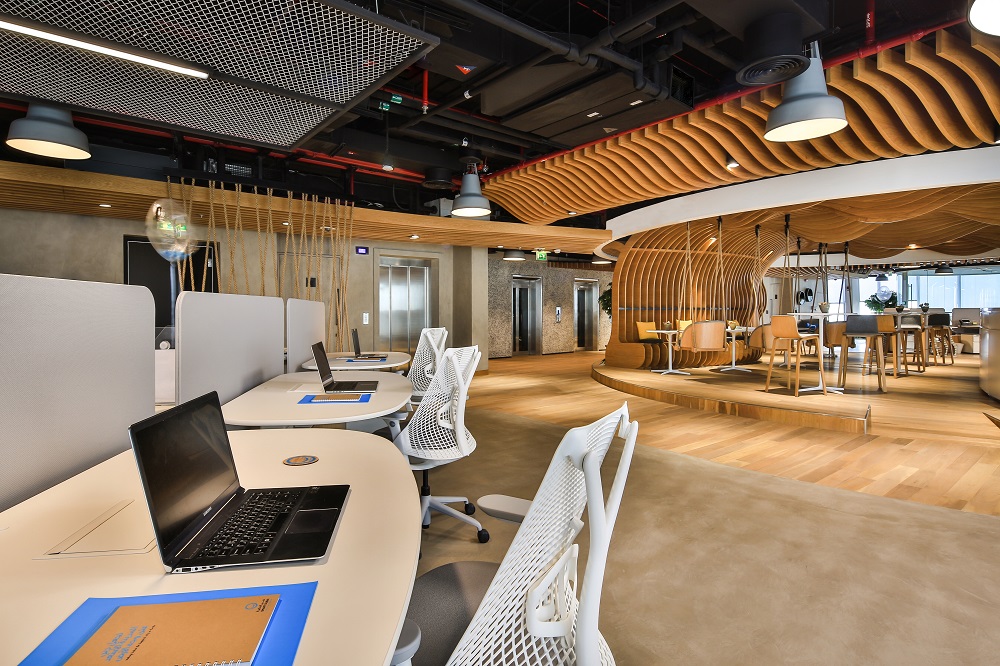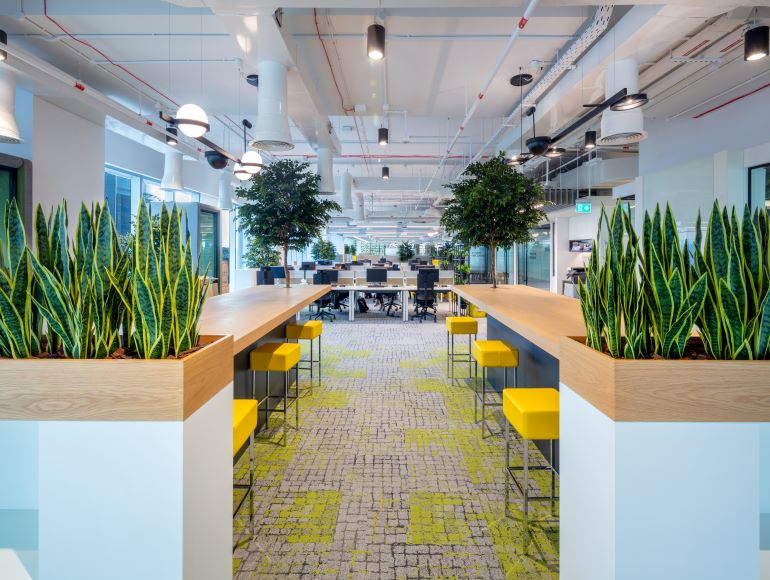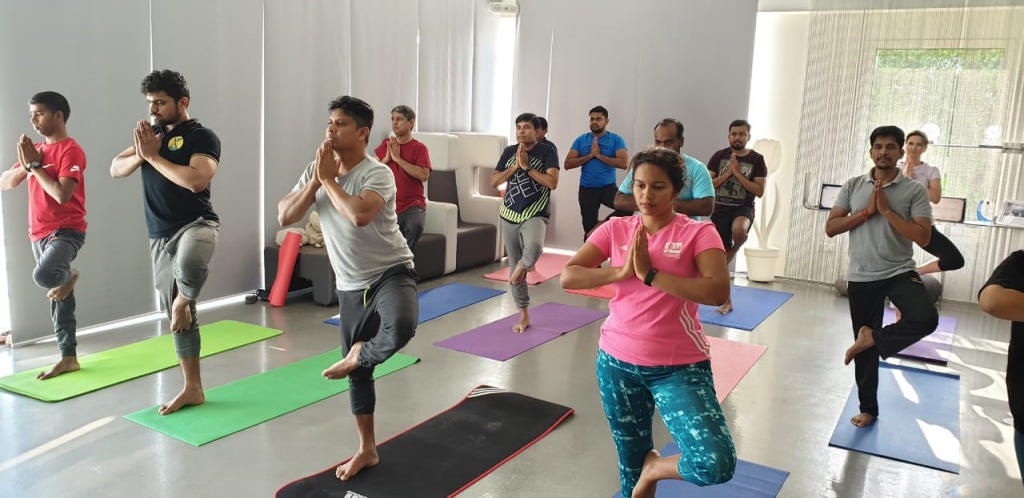‘Re-thinking’ the office space to make workplaces healthier and more sustainable for the safety and wellbeing of employees became more important than ever before.
At the start of 2020, nothing could have prepared us for what the world was soon to experience. The COVID-19 pandemic’s profound impact on daily life, society, and businesses, forced many of us into lockdown and to work from home.
In May 2020, when the UAE’s lockdown restrictions eased, companies had to quickly assess and adapt their current workplaces to meet new government guidelines and prepare for employees’ return to work. ‘Re-thinking’ the office space to make workplaces healthier and more sustainable for the safety and wellbeing of employees became more important than ever before.
As we look ahead to 2021, with the hope a new vaccine will reduce the infection rates and allow more people to return to workplaces, the impact of the pandemic is clearly embedded in next year’s fit out and workplace trends.
Here is a list of Summertown’s top trends to look out for in 2021:
1. Technology
COVID-19 drastically accelerated the implementation of digital workplace technology, especially when in support of digital resiliency. [1] Over the next 12 months, we anticipate we will see:
- Smarter buildings – with an increased focus on health and safety, companies are turning to more automated processes to enhance workspace operations, from air conditioning and heating, through to lighting and security.
- Touch-less sensor technology – technology that enables staff to avoid contact with frequently used surfaces such as lift buttons, light switches and bathroom taps is becoming of greater interest to employers. [2]
- State-of-the-art video conferencing technology – as the working world relies more on videoconferencing platforms such as Zoom, Microsoft Teams and Google Meet, equipping meeting rooms with reliable videoconferencing facilities has become a necessity.
- IT Connectivity – seamless IT connection to enable flexible working in the office and at home.
2. Flexible Workspaces
The pandemic led employers to move away from a traditional way of thinking that productivity is contingent upon set hours within an office environment. Shifting towards a more flexible workplace set-up will be a major trend in 2021. Which is where the ‘hybrid working’ model comes into play.
A combination of both working from home (WFH) and in the office/workspace, the hybrid working model focuses on the balance of employee productivity levels and face-to-face connection to determine the right combination.
 One workplace design option aligned to the hybrid model is activity-based working (ABW), which has a variety of workspaces that allow employees to choose where they work based on the task or activity. ABW is an established model that encompasses the notion of flexible workspaces, replacing the traditional fixed desk with open hot-desking, and embraces an autonomous ‘on demand’ culture of working.
One workplace design option aligned to the hybrid model is activity-based working (ABW), which has a variety of workspaces that allow employees to choose where they work based on the task or activity. ABW is an established model that encompasses the notion of flexible workspaces, replacing the traditional fixed desk with open hot-desking, and embraces an autonomous ‘on demand’ culture of working.
Physical fit out changes for hybrid workplaces should include reconfiguring the space to be more flexible, having spaces that facilitate team collaboration, and breakout zones to function as a social hub.
3. Wellbeing
Personal and professional stress has shaped a complex and anxious workforce that is more concerned and wary of the future than ever before. A COVID-19 Global Impact Study commissioned by Cigna revealed that the always-on culture, finance-related problems and overall health concerns led to an increase in stress levels among employees during and after the lockdown period. [3]
In the global study, the UAE ranked second highest after Thailand when it came to longer workdays, with 65 percent of the respondents admitting to working extended hours. It is clear that workplace wellbeing is crucial for boosting employee morale and positivity in organisations.
There is now greater awareness and understanding of the importance of mental wellbeing in the workplace, with the adoption of corporate employee health and wellness programmes gaining momentum in the UAE and globally. According to the professional body for HR and people development, the Chartered Institute of Personnel and Development (CIPD), “Investing in employee well-being can lead to increased resilience, reduced sickness absence and higher performance and productivity.” [4] Key to realising these benefits is to embed a health and wellbeing programme into a company’s culture and strategy with management endorsement. Common initiatives within these programmes can include access to mental health workshops, gym reimbursements, health coaching and nutritional support. [5]
4. Sustainability
A recent survey by Boston Consulting Group of more than 3,000 people across eight countries has found that in the wake of the pandemic people are more concerned—not less—about addressing environmental challenges and are more committed to changing their own behaviour to advance sustainability. [6] In 2021, we will likely see governments aligning their economic recovery initiatives with sustainable business development and practices. Employees will also place greater emphasis on working in healthier, safer and more sustainable workplace environments upon their return.
We also anticipate that there will be a growing demand for official third-party fit out certifications such as Leadership in Energy and Environmental Design (LEED), that demonstrate employer’s commitment to sustainable workplaces. The commitment to sustainability is even more pronounced among younger people, who have a stronger conviction that personal behaviour can make a difference in addressing environmental action, and who expect environmental concerns to be front and centre in recovery plans.
5. Health & Safety
Putting the health and safety of employees in the workplace first by adapting to today’s new norm of social distancing and strict personal hygiene is of utmost importance. Ensuring compliance to COVID-19 government regulations is a necessity – and this includes the maintenance of office hygiene. From the installation of hygiene stations equipped with protective items such as sanitizer and face masks, to anti-microbial materials or surfaces, and social distancing signage.
In June 2020, the International WELL Building Institute (IWBI) introduced the WELL Health Safety Rating, an evidence-based, third-party verified rating for all new and existing building and space types focused on operational policies, maintenance protocols, emergency plans and stakeholder engagement strategies to help organisations prepare their spaces for re-entry in a post COVID-19 environment. We are aiming to achieve this rating for our own office and expect to see many companies globally also aim for this rating to promote the long-term health and safety of people.
6. Biophilia: More than Just Turning the Office Green
 With the focus on enhancing employees’ experience and wellbeing in the workplace, biophilia is a trend we see continuing in 2021. Biophilia focuses on incorporating elements from nature into design to benefit human health and wellbeing – which include plants, light, and natural materials.
With the focus on enhancing employees’ experience and wellbeing in the workplace, biophilia is a trend we see continuing in 2021. Biophilia focuses on incorporating elements from nature into design to benefit human health and wellbeing – which include plants, light, and natural materials.
Workplace wellness is a key driver behind the rise of biophilic design, driven by our increased interest in ensuring our homes are healthy places to live. Having plants indoors is known to improve air quality by filtering air and removing toxins, as well as combat dry air caused by air-conditioning in an office environment. [7]
One of the most effective ways to increase occupant health in buildings is to provide natural lighting. Studies indicate that not only does exposure to sunlight have direct medical benefit—it is the main source of Vitamin D—but it also improves mood and concentration. [8] Incorporating living walls and room dividers has practical and space-enhancing benefits. Screens with integrated greenery offer flexible ways to section off private spaces in an open-plan office environment, as well as having noise-reduction benefits.
Conclusion
The COVID-19 pandemic impact on our workplaces is unprecedented, but it is also an opportunity to implement positive sustainable changes. ‘Rethinking’ the use of space is a priority for companies as they resume work in their office spaces again – and the above trends are expected to be encompassed in these changes.
At Summertown the health, safety and wellbeing of our employees has always been of utmost importance to us, and we are committed to creating a better future for the planet, the country, and our clients. We also have first-hand experience undertaking sustainable workplace fit outs that meet LEED certification, offering free LEED certified level certification to all clients with projects over 2,000sqm.
Contact us to discuss how we can help you find the right solution for your business today.
Reference:
[1] https://www.gartner.com/smarterwithgartner/6-trends-on-the-gartner-hype-cycle-for-the-digital-workplace-2020/
[2] https://www.workdesign.com/2020/07/how-technology-is-helping-reimagine-the-post-pandemic-workplace/
[3] https://gulfbusiness.com/covid-19-impact-how-significant-is-workplace-wellness-in-uae-based-offices/
[4] https://www.cipd.co.uk/knowledge/culture/well-being/factsheet#:~:text=Fostering%20employee%20well%2Dbeing%20is,employee%20engagement%20and%20organisational%20performance
[5] https://www.fond.co/blog/covid-19-corporate-wellness-program/
[6] https://www.bcg.com/publications/2020/pandemic-is-heightening-environmental-awareness
[7] https://trend-monitor.co.uk/design-trend-biophilia/
[8] https://www.researchgate.net/publication/303484362_Natural_Light_and_Productivity_Analyzing_the_Impacts_of_Daylighting_on_Students’_and_Workers’_Health_and_Alertness
